-
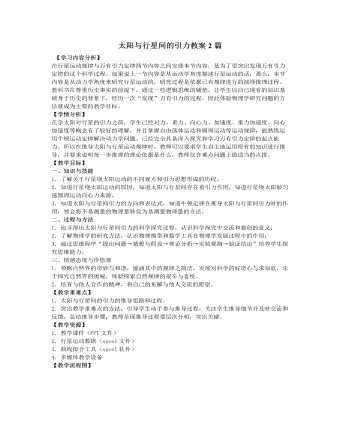
人教版新课标高中物理必修2太阳与行星间的引力教案2篇
【学习内容分析】在行星运动规律与万有引力定律两节内容之间安排本节内容,是为了更突出发现万有引力定律的这个科学过程。如果说上一节内容是从运动学角度描述行星运动的话,那么,本节内容是从动力学角度来研究行星运动的,研究过程是依据已有规律进行的演绎推理过程。教科书在尊重历史事实的前提下,通过一些逻辑思维的铺垫,让学生以自己现有的知识基础身于历史的背景下,经历一次“发现”万有引力的过程,因此体验物理学研究问题的方法就成为主要的教学目标。【学情分析】在学太阳对行星的引力之前,学生已经对力、重力、向心力、加速度、重力加速度、向心加速度等概念有了较好的理解,并且掌握自由落体运动和圆周运动等运动规律,能熟练运用牛顿运动定律解决动力学问题。已经完全具备深入探究和学习万有引力定律的起点能力。所以在推导太阳与行星运动规律时,教师可以要求学生自主地运用原有的知识进行推导,并要求说明每一步推理的理论依据是什么,教师仅在难点问题上做适当的点拨。
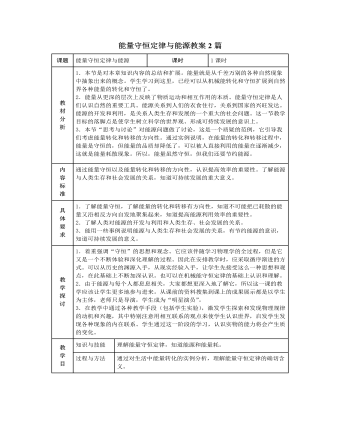
人教版新课标高中物理必修2能量守恒定律与能源教案2篇
世界能源问题的解决途径是什么?能源,是人类敕以生存和进行生产的不可缺少的资源.近年来,随着生产力的发展和能源消费的增长.能源问题已被列为世界上研究的重大问题之一.解决世界能源问题的根本途径,主要有两个方面:其一是广泛开源,其二是认真节流.所谓开源,就是积极开发和利用各种能源.在继续加紧石油勘探和寻找新的石油产地的同时,积极开发丰富的煤炭资源,还要大力开发水能,生物能等常规能源,加强核能、太阳能,风能、沼气,海洋能,地热能以及其他各种新能源的研究和利用,从而不断扩大人类的能源资源的种类和来源.所谓节流,就是要大力提倡节约能源.节能是世界上许多国家关心和研究的重要课题,甚至有人把节能称为世界的“第五大能源”,与煤、石油和天然气、水能、核能等并列.在节能方面,在有计划地控制人口增长的同时,重点要发挥先进科学技术的优势,提高各国的能源利用效率.

人教版新课标高中物理必修2曲线运动教案2篇
1、教师先演示投影:把小钢珠放在黑墨水瓶盖里转一下(内有一点点墨水),再放在半圆形有机玻璃轨道上运动并飞出,让钢珠在白纸上留下痕迹,同样在3/5半圆周,4/5半圆周上运动飞出,让学生猜测飞出方向由什么特点?(有机玻璃板说明:厚约5毫米,略小于小钢珠直径,圆弧半径15厘米,MN边稍长些,以便过MN做直线,根据半径大小确定圆心O位置。)学生猜想:切线方向师:已知圆弧半径为15厘米。如何验证?请用几何方法作图验证。生:标出飞出点和圆心,做圆心和飞出点的连线,用量角尺量出该连线和飞出轨迹直线的夹角,是否90度。2、再分组实验,提醒同桌配合,小心钢珠滚跑。实验完毕,要求作图验证,并互相讨论交流。3、交流和结论:师:要引导学生得出正确的科学结论:“圆周运动的物体的速度方向为该点的切线方向”,而不能直接得出“曲线运动的的物体速度方向为该点的切线方向”。
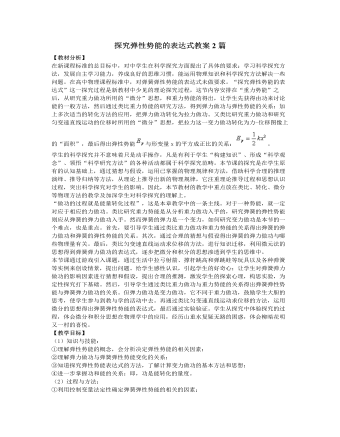
人教版新课标高中物理必修2探究弹性势能的表达式教案2篇
“做功的过程就是能量转化过程”,这是本章教学中的一条主线。对于一种势能,就一定对应于相应的力做功。类比研究重力势能是从分析重力做功入手的,研究弹簧的弹性势能则应从弹簧的弹力做功入手。然而弹簧的弹力是一个变力,如何研究变力做功是本节的一个难点,也是重点。首先,要引导学生通过类比重力做功和重力势能的关系得出弹簧的弹力做功和弹簧的弹性势能的关系。其次,通过合理的猜想与假设得出弹簧的弹力做功与哪些物理量有关。最后,类比匀变速直线运动求位移的方法,进行知识迁移,利用微元法的思想得到弹簧弹力做功的表达式,逐步把微分和积分的思想渗透到学生的思维中。本节课通过游戏引入课题,通过生活中拉弓射箭、撑杆跳高和弹跳蛙等玩具以及各种弹簧等实例来创设情景,提出问题。给学生感性认识,引起学生的好奇心;让学生对弹簧弹力做功的影响因素进行猜想和假设,提出合理的推测,激发学生的探索心理,构思实验,为定性探究打下基础。然后,引导学生通过类比重力做功与重力势能的关系得出弹簧弹性势能与弹簧弹力做功的关系。
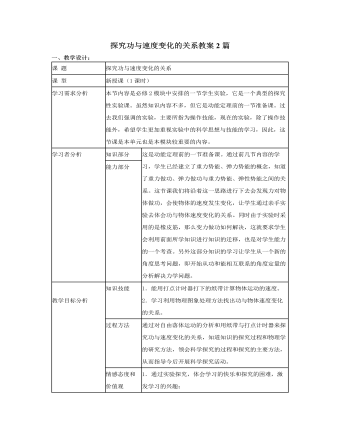
人教版新课标高中物理必修2探究功与速度变化的关系教案2篇
说明:“倍增法”是一种重要的物理方法,历史上库仑在研究电荷间的相互作用力时曾用过此法,但学生在此前的物理学习中可能未曾遇到类似例子,因此引导学生通过交流,领会“倍增法”的妙处,这是本节课的一个要点.可用体育锻炼中的“拉力器”来类比。(2)该方案消除摩擦力影响的方法:所用的消除方法与实验方案2一样。也可使用气垫导轨代替木板,以更好地消除摩擦影响。(3)小车速度的确定方法:①确定打出来的点大致呈现什么规律:先密后疏(变加速),再均匀分布(匀速);②应研究小车在哪个时刻的速度:在橡皮筋刚恢复原长时小车的瞬时速度,即纸带上的点刚开始呈现均匀分布时的速度;③应如何取纸带上的点距以确定速度:由于实验器材和每次操作的分散性,尤其是橡皮筋不可能长度、粗细完全一致,使得每次改变橡皮筋的条数后,纸带上反映小车匀速运动的点数和点的位置,不一定都在事先的设定点(即用一条橡皮筋拉小车,橡皮筋刚好恢复原长时纸带上的点)处。

人教版新课标高中物理必修2验证机械能守恒定律教案2篇
教学目标㈠知识与技能1.要弄清实验目的,本实验为验证性实验,目的是利用重物的自由下落验证机械能守恒定律。2.要明确实验原理,掌握实验的操作方法与技巧、学会实验数据的采集与处理,能够进行实验误差的分析,从而使我们对机械能守恒定律的认识,不止停留在理论的推导上,而且还能够通过亲自操作和实际观测,从感性上增加认识,深化对机械能守恒定律的理解。3.要明确织带选取及测量瞬时速度简单而准确的方法。㈡过程与方法1.通过学生自主学习,培养学生设计实验、采集数据,处理数据及实验误差分析的能力。2.通过同学们的亲自操作和实际观测掌握实验的方法与技巧。3.通过对纸带的处理过程培养学生获取信息、处理信息的能力,体会处理问题的方法,领悟如何间接测一些不能直接测量的物理量的方法。
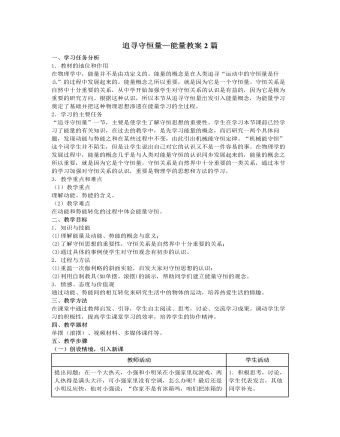
人教版新课标高中物理必修2追寻守恒量—能量教案2篇
一、学习任务分析1.教材的地位和作用在物理学中,能量并不是由功定义的。能量的概念是在人类追寻“运动中的守恒量是什么”的过程中发展起来的。能量概念之所以重要,就是因为它是一个守恒量。守恒关系是自然中十分重要的关系,从中学开始加强学生对守恒关系的认识是有益的,因为它是极为重要的研究方向。根据这种认识,所以本节从追寻守恒量出发引入能量概念,为能量学习奠定了基础并把这种物理思想渗透在能量学习的全过程。2.学习的主要任务“追寻守恒量”一节,主要是使学生了解守恒思想的重要性。学生在学习本节课前已经学习了能量的有关知识,在过去的教学中,是先学习能量的概念,而后研究一两个具体问题,发现动能与势能之和在某些过程中不变,由此引出机械能守恒定律。“机械能守恒”这个词学生并不陌生,但是让学生说出自己对它的认识又不是一件容易的事。
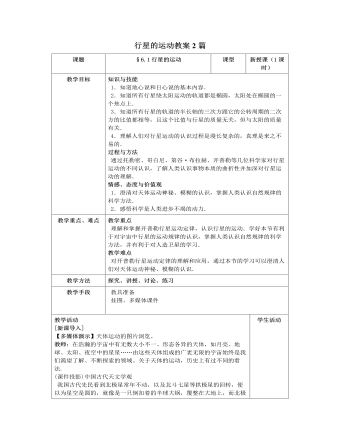
人教版新课标高中物理必修2行星的运动教案2篇
知识与技能1.知道地心说和日心说的基本内容.2.知道所有行星绕太阳运动的轨道都是椭圆,太阳处在椭圆的一个焦点上.3.知道所有行星的轨道的半长轴的三次方跟它的公转周期的二次方的比值都相等,且这个比值与行星的质量无关,但与太阳的质量有关.4.理解人们对行星运动的认识过程是漫长复杂的,真理是来之不易的.过程与方法通过托勒密、哥白尼、第谷·布拉赫、开普勒等几位科学家对行星运动的不同认识,了解人类认识事物本质的曲折性并加深对行星运动的理解.情感、态度与价值观1.澄清对天体运动裨秘、模糊的认识,掌握人类认识自然规律的科学方法.2.感悟科学是人类进步不竭的动力.教学重点理解和掌握开普勒行星运动定律,认识行星的运动.学好本节有利于对宇宙中行星的运动规律的认识,掌握人类认识自然规律的科学方法,并有利于对人造卫星的学习.
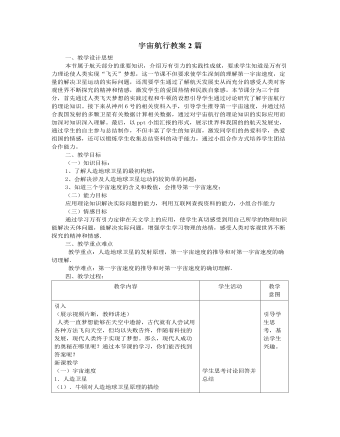
人教版新课标高中物理必修2宇宙航行教案2篇
动画展示三个宇宙速度(四) 让学生具有振兴中华的使命感与责任感本节课的最后,播放了一段美国登月的视频,让学生发现一些奇妙的物理现象,引导学生发现月球的背景是什么颜色,宇航员行走的模样等等,预计不久的将来,哪个国家也将登上月球,同学们高呼“中国”,那么我们现在能做些什么呢,让同学感想到:我们是祖国的未来的希望,现在需要努力学习科学文化知识,将来为祖国的航天事业做贡献。要培养学生坚韧不拨、勇于探索、协力合作的科学精神以及严谨求实、谦虚谨慎、勇于质疑科学态度;也要培养学习者热爱科学、热爱祖国的情感;努力学习、振兴中华的责任感。这些策略在本案例中得到了体现。(五)练习反馈,拓展延伸:[例题1]“2003年10月15日9时,我国神舟五号宇宙飞船在酒泉卫星发射中心成功发射,把我国第一位航天员杨利伟送入太空。飞船绕地球飞行14圈后,于10月16日6时23分安全降落在内蒙古主着陆场。”
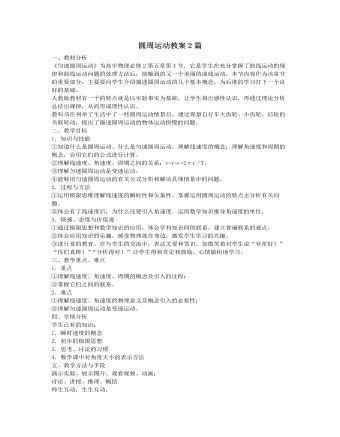
人教版新课标高中物理必修2圆周运动教案2篇
《匀速圆周运动》为高中物理必修2第五章第4节.它是学生在充分掌握了曲线运动的规律和曲线运动问题的处理方法后,接触到的又一个美丽的曲线运动,本节内容作为该章节的重要部分,主要要向学生介绍描述圆周运动的几个基本概念,为后继的学习打下一个良好的基础。人教版教材有一个的特点就是以实验事实为基础,让学生得出感性认识,再通过理论分析总结出规律,从而形成理性认识。教科书在列举了生活中了一些圆周运动情景后,通过观察自行车大齿轮、小齿轮、后轮的关联转动,提出了描述圆周运动的物体运动快慢的问题。二、教学目标1.知识与技能①知道什么是圆周运动、什么是匀速圆周运动。理解线速度的概念;理解角速度和周期的概念,会用它们的公式进行计算。②理解线速度、角速度、周期之间的关系:v=rω=2πr/T。③理解匀速圆周运动是变速运动。④能够用匀速圆周运动的有关公式分析和解决具体情景中的问题。
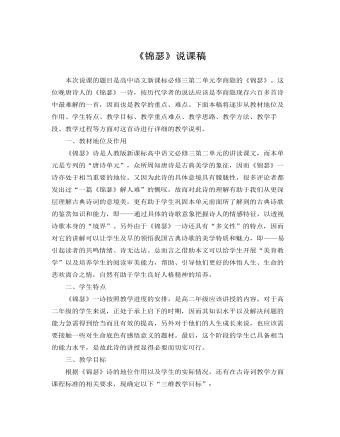
人教版高中语文必修3《锦瑟》说课稿
三、教学目标根据《锦瑟》诗的地位作用以及学生的实际情况,还有在古诗词教学方面课程标准的相关要求,现确定以下“三维教学目标”:(一)知识与技能目标:感受体悟古典诗歌的意境美,发挥合理的主观能动性进行创新性的阅读鉴赏,正确认识意象在诗歌意境中的重要作用。并在上述的基础上提高鉴赏能力和审美情操。(二)过程与方法目标:《锦瑟》诗的讲解采用“引导与自我生成”的方法,从老师的引导开始,以学生的研讨交流再加之教师的总结结束。利用教师引导和师生互动刺激学生的领悟力,提高学生的认知水平与能力。(三)情感态度价值观目标:培养学生在尊重传统文化的基础上热爱祖国自己文化的态度,让学生正确认识古典诗词的精神美。最后在自我感悟中陶冶情操,明心启智。

人教版新课标高中地理必修2第六章第一节人地关系思想的演变教案
环境问题 是伴着人口问题、资源问题和发展问题产生。本质是发展问题 ,可持续发展。6分析可持续发展的概念、内涵和 原则?可持续发展的含义:可持续发展是这样的发展,它既满足当代人的需求,而又不损害后代人满足其需求的能力。可持续发展的内涵:生态持续发展 ,发展的基础;经济持续发展,发展条件;社会持续发展,发展目的。可持续发展的原则:公平性原则——代内、代际、人与物、国家与地区之间;持续性原则——经济活动保持在资源环境承载力之内;共同性原则— —地球是一个整体。【总结新课】可持续发 展的含义:可持续发展是这样的发展,它既满足当代人的需求,而又不损害后代人满足其需求的能力。可持续发展的内涵:生态持续发展,发展的基础;经济持续发展,发展条件;社会持续发展,发展目的。

必修一牛顿第一定律教案
(二)?过程与方法? 4.?观察生活中的惯性现象,了解力和运动的关系? 5.?通过实验加深对牛顿第一定律的理解? 6.?理解理想实验是科学研究的重要方法? (三)?情感态度与价值观? 7.?通过伽利略和亚里士多德对力和运动关系的不同认识,了解人类认识事物本质的曲折性? 8.?感悟科学是人类进步的不竭动力

新人教版高中英语必修3Unit 3 Diverse Cultures教学设计四
该板块的活动主题是“介绍一个有显著文化特征的地方”( Describe a place with distinctive cultural identity)。该板块通过介绍中国城继续聚焦中国文化。本单元主题图呈现的是旧金山中国城的典型景象, Reading and Thinking部分也提到中国城,为该板块作铺垫。介绍中国城的目的主要是体现中国文化与美国多元文化的关系,它是美国多元文化的重要组成部分。中国城也是海外华人的精神家园和传播中国文化的重要窗口,外国人在中国城能近距离体验中国文化。1. Read the text to understand the cultural characteristics of Chinatown in San Francisco and the relationship between Chinese culture and American multiculturalism;2. Through reading, learn to comb the main information of the article, understand the author's writing purpose and writing characteristics;3. Learn to give a comprehensive, accurate, and organized description of the city or town you live in;Learn to revise and evaluate your writing.Importance:1. Guide the students to read the introduction of Chinatown in San Francisco and grasp its writing characteristics;2. Guide students to introduce their city or town in a comprehensive, accurate and organized way;3. Learn to comb the main information of the article, understand the author's writing purpose, and master the core vocabulary.

新人教版高中英语必修3Unit 3 Diverse Cultures教学设计一
Activity 81.Grasp the main idea of the listening.Listen to the tape and answer the following questions:Who are the two speakers in the listening? What is their relationship?What is the main idea of the first part of the listening? How about the second part?2.Complete the passage.Ask the students to quickly review the summaries of the two listening materials in activity 2. Then play the recording for the second time.Ask them to complete the passage and fill in the blanks.3.Play the recording again and ask the students to use the structure diagram to comb the information structure in the listening.(While listening, take notes. Capture key information quickly and accurately.)Step 8 Talking Activity 91.Focus on the listening text.Listen to the students and listen to the tape. Let them understand the attitudes of Wu Yue and Justin in the conversation.How does Wu Yue feel about Chinese minority cultures?What does Justin think of the Miao and Dong cultures?How do you know that?2.learn functional items that express concerns.Ask students to focus on the expressions listed in activity. 3.And try to analyze the meaning they convey, including praise (Super!).Agree (Exactly!)"(You're kidding.!)Tell me more about it. Tell me more about it.For example, "Yeah Sure." "Definitely!" "Certainly!" "No kidding!" "No wonder!" and so on.4.Ask the students to have conversations in small groups, acting as Jsim and his friends.Justin shares his travels in Guizhou with friends and his thoughts;Justin's friends should give appropriate feedback, express their interest in relevant information, and ask for information when necessary.In order to enrich the dialogue, teachers can expand and supplement the introduction of Miao, dong, Lusheng and Dong Dage.After the group practice, the teacher can choose several groups of students to show, and let the rest of the students listen carefully, after listening to the best performance of the group, and give at least two reasons.

新人教版高中英语必修3Unit 3 Diverse Cultures教学设计三
The price is the same as(the price was)before the war.价格与战前相同。(4)定语从句中的“关系代词+助动词be”可以省略。The ticket(that/which was)booked by his sister has been sent to him.他妹妹订的那张票已送到了他那里。Step 5 PracticeActivity 3(1) Guide students to complete the four activities in the Using Structures part of exercise book, in which activities 1 and 2 focus on ellipsis in dialogue answers, activity 3 focus on signs and headlines, two typical situations where ellipsis is used, and activity 4 focus on ellipsis in diary, an informal style.(2) Combine the examples in the above activities, ask students to summarize the omitted situations in groups, and make their own summary into a poster, and post it on the class wall after class to share with the class.(This step should give full play to the subjectivity of students, and teachers should encourage students to conclude different ellipsis phenomena according to their own understanding, they can conclude according to the different parts omitted in the sentence.)Step 6 Homework1. Understand and master the usages of ellipsis;2. Finish the other exercises in Using structures of Workbook.1、通过本节内容学习,学生是否理解和掌握省略的用法;2、通过本节内容学习,学生能否根据上下文语境或情景恢复句子中省略的成分,体会使用省略的效果;3、通过本节内容学习,学生能否独立完成练习册和导学案中的相关练习。

新人教版高中英语必修3Unit 3 Diverse Cultures教学设计二
(2)Consolidate key vocabulary.Ask the students to complete the exercises of activity 6 by themselves. Then ask them to check the answers with their partners.(The first language:Damage of the 1906 San Francisco earthquake and fire.A second language: Yunnan - one of the most diverse provinces in China).Step 5 Language points1. The teacher asks the students to read the text carefully, find out the more words and long and difficult sentences in the text and draw lines, understand the use of vocabulary, and analyze the structure of long and difficult sentences.2. The teacher explains and summarizes the usage of core vocabulary and asks the students to take notes.3. The teacher analyzes and explains the long and difficult sentences that the students don't understand, so that the students can understand them better.Step 6 Homework1. Read the text again, in-depth understanding of the text;2. Master the use of core vocabulary and understand the long and difficult sentences.3. Complete relevant exercises in the guide plan.1、通过本节内容学习,学生是否理解和掌握阅读文本中的新词汇的意义与用法;2、通过本节内容学习,学生能否结合文本特点了解文章的结构和作者的写作逻辑;3、通过本节内容学习,学生能否了解旧金山的城市风貌、文化特色,以及加利福尼亚州的历史,体会多元文化对美国的影响。
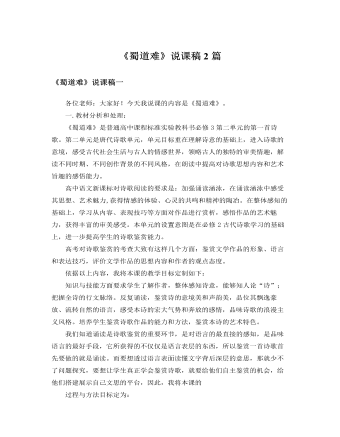
人教版高中语文必修3《蜀道难》说课稿2篇
(1)“问君西游何时还……使人听此凋朱颜。”诗题下未注明送何人入蜀,所以这里的“问君”无妨假定实有其人,可以读得亲切一些。将行而问“何时还”,已有不可行之意,重音要落在“不可攀”三字上,当用劝说的语气读。以下四句借鸟声渲染旅途中悲凉凄清的氛围,读时要放低声调,有干里孤身之感,至“愁空山”徐徐而上。然后用感喟的语调读主旨句,至“凋朱颜”略作一顿,以示意犹未尽。(2)“连峰去天不盈尺……胡为乎来哉!”仍是说不可行,但内容加深了一层,因为说的是蜀道的险恶。前四句不是纯客观的描写,读时须设想这是旅游者攀援于“连峰”“绝壁”之上置身于“飞湍瀑流”之间,要使听者感到惊心动魄。读后可作稍长停顿,再用“其险也如此”缓缓收住。末句是诗人借用蜀人的口气,对历险而来的游者深表叹息——“胡为乎来哉”不是询问,当用降调读,暗含“何苦而来”之意。

新人教版高中英语必修3Unit 1 Festivals and Celebrations教学设计二
1. Ss look at the picture and scan the passage to understand the main idea while teacher is giving the following questions to inspire Ss to think.*Where are those people?*What are they doing?*Why are they so excited?2. Ss complete the passage with the appropriate -ing form. Then discuss and check the answers with class.Answers: boring, interesting, taking, exciting, amazing3. The teacher raises questions for the students to discuss and encourages them to express their opinions.*Do you like La Tomatina? Why or why not?4. Each group representative reports the discussion result, the teacher gives feedback and the evaluation.Step 6 PracticeActivity 41. Ss complete the Ex 2 in Using structures.2. Check the answers after finishing the exercises.①The dragon boat races are the most exciting part of the Dragon Boat Festival.② The children were excited to go Easter egg hunting.③What an amazing performance! This is the best music festival I have ever been to.④We were amazed by her funny-looking hat.⑤His inspiring speech at the conference won the admiration/ favour of the audience.⑥This is a challenging game to test your memory and observation capabilities. 3. T asks Ss to finish Ex 3 and 4 in Using structures by themselves, then check the answers with class.Step 6 Homework1. Understand and master the functions and usage of the -ing form;2. Finish the other exercises in Using structures.1、通过本节内容学习,学生是否理解和掌握动词-ing形式作定语和表语的功能和意义;2、通过本节内容学习,学生能否在理解文段内容的基础上,根据上下文语境和表达逻辑,能正确运用动词-ing形式描述节日庆典。3、通过本节内容学习,学生是否归纳和积累用于表达情绪的相关词汇。

新人教版高中英语必修3Unit 1 Festivals and Celebrations教学设计一
本板块的活动主题是“谈论节日活动”(Talk about festival activities),主要是从贴近学生日常生活的角度来切入“节日”主题。学生会听到发生在三个国家不同节日场景下的简短对话,对话中的人们正在参与或将要亲历不同的庆祝活动。随着全球化的进程加速,国际交流日益频繁,无论是国人走出国门还是外国友人访问中国,都已成为司空见惯的事情。因此,该板块所选取的三个典型节日场景都是属于跨文化交际语境,不仅每组对话中的人物来自不同的文化背景,对话者的身份和关系也不尽相同。1. Master the new words related to holiday: the lantern, Carnival, costume, dress(sb)up, march, congratulation, congratulate, riddle, ceremony, samba, make - up, after all. 2. To understand the origin of major world festivals and the activities held to celebrate them and the significance of these activities;3. Improve listening comprehension and oral expression of the topic by listening and talking about traditional festivals around the world;4. Improve my understanding of the topic by watching pictures and videos about different traditional festivals around the world;5. Review the common assimilation phenomenon in English phonetics, can distinguish the assimilated phonemes in the natural language flow, and consciously use the assimilation skill in oral expression. Importance:1. Guide students to pay attention to the attitude of the speaker in the process of listening, and identify the relationship between the characters;2. Inspire students to use topic words to describe the festival activities based on their background knowledge. Difficulties:In the process of listening to the correct understanding of the speaker's attitude, accurately identify the relationship between the characters.